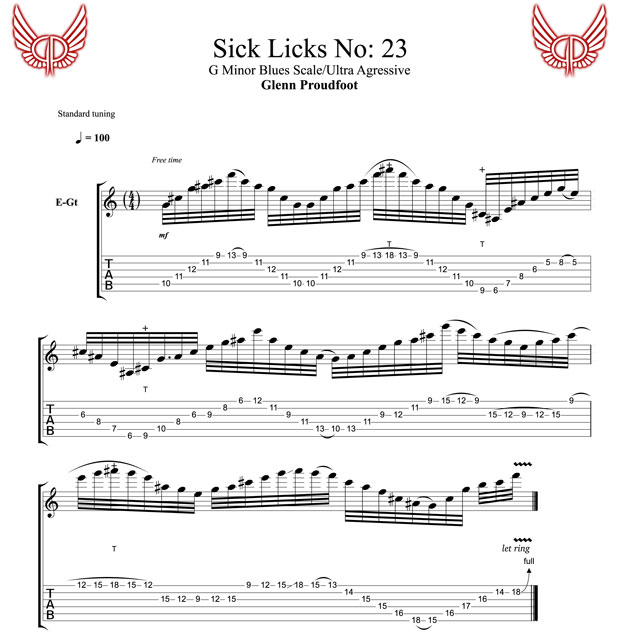Sick Licks: Taking the G Minor Blues Scale to the Outer Limits

In this Sick Lick, I'm using the G minor blues scale.
It's incredible the sonic form this scale takes when used higher up the neck. It really creates a sound far from its original blues roots when you apply arpeggios and legato along with some wide intervallic playing.
It's so incredibly diverse and adaptable to so many different styles of music, which makes it such a popular scale with so many guitar players.
The notes in this scale are G, A#, C, C#, D and F. The C# is the blue note or the flat five. This is the note that is added to the original pentatonic scale to make it the blues scale. It is very important to understand the difference between the two scales, because each one deserves the same amount of attention and respect.
The flat five is a note we commonly add to the pentatonic, but the pentatonic alone is a very powerful scale and shouldn't be forgotten or simply substituted for the blues scale all the time. I tend to switch in and out of them to create a different soundscope. So remember to practice them separately as individual scales all over the neck.
The Lick
I start this lick on the 10th fret of the A string with a five-string arpeggio moving down to the high E, then back again. The second time I play the arpeggio, I tap the 18th fret with my right middle finger to create a longer legato line, then we move back down the arpeggio the same as before.
Get The Pick Newsletter
All the latest guitar news, interviews, lessons, reviews, deals and more, direct to your inbox!
From here, I fret the ninth fret with my left thumb to create the pivot so I can swing my left hand over the top and start fretting the guitar. Once my left hand is on position, I play a five-string arpeggio starting on the sixth fret of the low E.
We play this arpeggio up and back with the same fingerings. From there, I (once again) fret the ninth fret with my left thumb to create the pivot to swing my left hand back around to fret the guitar in the traditional way.
The next section is a combination of three-string arpeggios and legato. The legato section is a little less complicated than it looks. All I'm doing is trilling this in one position, while on the second time I add the tapped note on the 18th fret to create the longer legato sound.
I finish this lick with a six-string arpeggio leading into a five-string arpeggio, then finishing with a bend.
There is so much information in this lick; I suggest breaking it down and practicing a section at a time. It's not necessary to be able to play the whole thing at this speed. It's just an example of how far you can take these scales and what you can do with them.
I hope you enjoy! Please join me on YouTube here.

Australia's Glenn Proudfoot has played and toured with major signed bands and artists in Europe and Australia, including progressive rockers Prazsky Vyber. Glenn released his first instrumental solo album, Lick Em, in 2010. It is available on iTunes and at glennproudfoot.com. Glenn was featured in the October 2010 issue of Guitar World and now creates "Betcha Can’t Play This" segments and lessons for GW. Glenn also has a monthly GW column, "Loud & Proud," which offers insight into his style and approach to the guitar. Glenn is working on a project with Ezekiel Ox (ex Mammal) and Lucius Borich (Cog), which is managed by Ted Gardner, ex-Tool and Jane's Addiction manager. The band has done pre-production on 22 tracks and is set to hit the studio and finish their first studio album. The album is set for release in 2012. Glenn also is working on the followup to his debut album; it, too, will be released in 2012.









